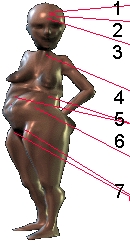2.7 Hormones and behaviour
Sources: Rosenzweig, lectures spring 2001 at La Trobe University, by Dr. Russel Conduit, Dr. Stephen Kent, Dr. Sheila Crewter.
2.7.1 How hormones act
Specialised cells secrete hormones into the bloodstream. Hormones are chemicals. The bloodstream carries the hormones to other parts of the body, where they act on target tissue to produce physiological effects (Rosenzweig, 1999). Many hormones are produced by endocrine glands (which are ductless). Other tissues, like the heart and kidney, also secrete hormones. Even plants use chemical signals which are included in what we call hormones.
 |
|
2.7.1.1 Types of chemical communication
1. Synaptic communication (neurocrine function).
2. Autocrine communication. A hormone acts on the releasing cell itself.
3. Paracrine communication. The hormone diffuses to nearby cells and affect the nearer cells stronger.
4. Endocrine communication. The hormone is released into the bloodstream and may affect target tissue far away in the body.
5. Pheromone communication. Chemical that act between different members of one species.
6. Allomone communication. Chemicals that act between species.